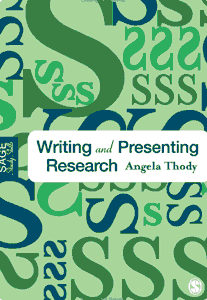
Writing And Presenting Research
By Professor Angela Thody
Emerita Professor at the International Institute for Educational Leadership,
University of Lincoln.
Chapter 6, Section 2, pp 79-81.
Selection and Reduction
6.2 HOW LITTLE DO YOU NEED?
It’s challenging to realize that what seems wildly exciting and important to you as the discoverer is not always seen in the same way by your intended audience, nor do they need as much detail as researchers think is vital. Your ability, and willingness, to degrade, summarize or simplify data is therefore an important pre-requisite to successful presentation of research.
The advertisement (omitted from excerpt) shows how far it is possible to reduce data while still transmitting the principal findings in a way that establishes their validity.
This is not to suggest that all research should be written or presented like advertisements but to demonstrate that a great deal can be conveyed in very few words -- an extract from the web site reporting the research -- gives some indication of the extent to which the data had to be reduced, and also how it has been adapted for different audiences and purposes (Chs 3 and 4).
The development of both a men’s and a women’s formula (click for info) began with careful planning of research protocols, assembling a team to conduct the first rigorous double blind placebo study in Philadelphia and subsequently two more teams to independently test the women’s formula on reproductive aged and postmenopausal women. Importantly, all 3 studies achieved peer-review acceptance and were published in 3 different prestigious scientific journals. The first study on men testing the male pheromone formula (Winnifred B. Cutler, Ph.D (click for bio)., Erika Friedmann, Ph.D., Norma L. McCoy, Ph.D. Archives of Sexual Behavior Vol. 27, No 1, 1998) was followed by two consecutive experiments testing the female formula (click for more).
In the first women’s study, Dr. Norma McCoy, a distinguished professor of Psychology at San Francisco State University and her graduate student Lisa Pitino investigated 19 to 47 year olds. Dr. McCoy reported that pheromone users got significantly and substantially more sexual attention than placebo users: more sexual intercourse, more hugging/petting/kissing, more sleeping next to a romantic partner, and more formal dates. (Pheromonal Influences on Sociosexual Behavior in Young Women. Physiology and Behavior 75 (March 2002) 367-375 Norma L. McCoy, Lisa Pitino).
In January 2005, the positive results of the postmenopausal women’s experiment were published. (Vol 41: 372-380, No.4, November 2004. The Journal of Sex Research Pheromonal Influences on Sociosexual Behavior in Postmenopausal Women. Rako, Friebely) (Cutler, 2005).
Dr Cutler’s research is also reported in several books and numerous articles. Lest you have ethical concerns about my inclusion of a commercial product in this book, I am not receiving commission nor samples for using this advertisement.
END OF EXCERPT
COMMENT FROM ATHENA INSTITUTE: Both Athena Pheromone 10:13tm for women and Athena Pheromone 10Xtm for men are cosmetics that can increase your attractiveness to the opposite sex. Neither product is an “aphrodisiac.”